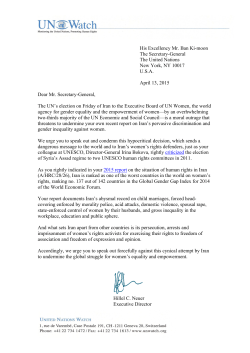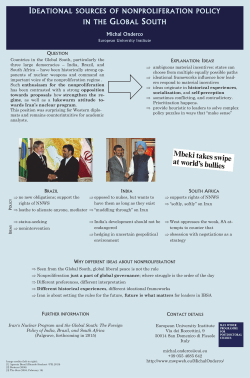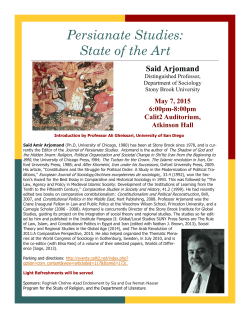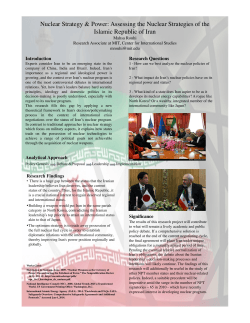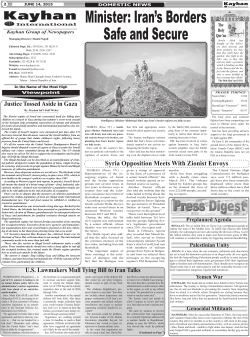
flyer Iran - Paleoseismicity.org
Tectonic and Geodynamic evolution of Eastern Iran International Workshop November 2-6, 2015 Scientific Committee M. Bröcker (Univ Münster), E. Saccani (Univ. Ferrara), M. Khatib (Univ. Birjand), R. Walker (Univ. Oxford), F. Rossetti (Univ. Roma 3), J.P. Burg (ETH Zürich), S-L. Chung (NTU Taipei), B. Vrielynck (UPMC Paris), Ling CHEN (IGG-CAS, Beijing) Organizing Committee J. Omrani (GSI, Tehran), P. Agard (UPMC, Paris) M. Zarrinkoub (U. Birjand) and H. Whitechurch (U. Strasbourg) "Tectonic and geodynamic evolution of Eastern Iran" An international workshop on the evolution of the Eastern Iran realm, from present-day active tectonics back into late Cretaceous subduction and ocean closure, comprising 1.5 days of seminars in Tehran and Birjand and 3 days of field excursion in Eastern Iran showcasing the variety of Sistan's geological highlights (ophiolites, deformation events, sedimentary basins, ore-mineralizations...). Rationale Halfway between the Zagros mountains and the Himalayas, the Sistan region is a major geological landmark of Eastern Iran and a crucial witness of both Iran tectonics and regional-scale geodynamics. Extending for more than 700 km along the eastern border of Iran with Afghanistan, the Sistan orogenic belt is regarded as a Mesozoic branch of the Neotethys (probably active from ~110 to ~50 Ma) later turned to a collisional orogenic belt. Despite hosting a wealth of ophiolite remnants, Tertiary magmatics and major, late Tertiary strike-slip faults, data on the polyphase tectonic, magmatic and stratigraphic evolution are particularly scarce. No comprehensive tectonic and geodynamic investigations were conducted since Stöcklin (1968) and early geological mappings in the late 1970’s (Tirrul et al., 1983). As a result, major, first-order tectonic and geodynamic uncertainties still remain: what is the paleogeography of the Central Iranian-Afghan blocks, the nature, age and origin of the Sistan ocean and obducted ophiolites (and their relationships to the Sabzevar or Nain-Baft ophiolites), the timing of closure and collision (and also subduction polarity), the Cenozoic tectonic evolution of the belt in the frame of the ArabiaEurasia and India-Eurasia collisions,...? Time has come to reappraise the geological evolution of Sistan in order to gain insights on regional-scale Neotethyan geodynamics between the Zagros and the Himalayas, as well as on rifting/obduction/subduction processes that are only mildly overprinted by later continental collision. This workshop intends to address some of these key issues, stimulate ideas and foster research projects on Eastern Iran. SCHEDULE Ø Monday, morning of Nov. 2 — Tehran, Geological Survey of Iran "Tectonic and geodynamic evolution of Iran" Ø Tuesday, Nov. 3 — Birjand, University of Birjand "Tectonic and geodynamic evolution of Eastern Iran" Ø Wenesday, Nov. 4 through to Friday, Nov. 6 Field excursion around Birjand Day 1 The Sistan suture zone, from Birjand to Sulabest: from Active tectonics back into (late Cretaceous) subduction and ocean closure • Introduction and excursion overview • Active Pleistocene to present-day fault in Birjand • Mio-Pliocene volcanism • Eo-Oligocene volcanic breccias • Porang fault: a major active NS trending fault • Sistan suture: past ocean and subduction processes • Collision and paleostress reconstructions Day 2 Sistan ophiolites: obducted ophiolites, mélange formation and late mineralizations • Fragments and slices of oceanic lithosphere • Seafloor structure and magmatic production • Listvinite and late mineralizations across ophiolite slices • Ophiolites and colored mélanges • Reworking and uplift during Tertiary deformation Day 3 Tectonic evolution, from the late Cretaceous to Present: overall cross-sections and geologic/geodynamic implications • Obducted ophiolite and metamorphic sole • Cretaceous to Eocene flyschs and wildflyschs • Eocene sedimentary basins and later intrusions • Brittle and active tectonics Anticipated itinerary for the field excursion
© Copyright 2025

